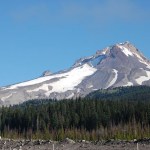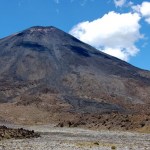Nature Climate Change has wandered into political science with a study from Stanford University. Seth Werfel's examination of the "crowding-out" effect — the idea that humans have a tough time pursuing more than one strategy to solve a problem — is worth considering, even if its finding aren't exactly earth-shattering.
The problem is laid out right off the top and requires no further explanation:
Household actions and government policies are both necessary to mitigate the effects of climate change. However, household behaviour may crowd out public support for government action by…
mitigation
One of the most important and threatening risks of climate change is sea-level rise (SLR). The mechanisms are well understood, and the direction of changes in sea-level is highly certain – it is rising and the rate of rise will accelerate. There remain plenty of uncertainties (i.e., a range of possible outcomes) about the timing and rate of rise that have to do with how fast we continue to put greenhouse gases in the atmosphere, the responses of (especially) ice sheets in Greenland and Antarctica, and the sensitivity of the climate.
Even little changes can have big consequences. As we saw…
It's hard to argue against funding scientific research. But let me try.
This past week 18 experts assembled as the Task Force on Climate Remediation Research released the product of its collective wisdom. A creation of the Bipartisan Policy Center, which the New York Times' Cornelia Dean describes as "a research organization based in Washington founded by four senators — Democrats and Republicans — to offer policy advice to the government," the task force concluded that the U.S. should be spending unspecified sums on research into what is colloquially known as climate hacking. Most everyone…
Way back when I was just a novice environmentalist, Greenpeace seemed like a good idea. It published a decent newsletter, was drawing attention to otherwise neglected issues, and, while understandably suspicious of technology, seemed to have more than a grudging respect for science as a tool to preserve those things worse preserving. It was one of the few NGOs that received what little I could afford to donate to charitable causes. I don't regret supporting them in the 80s, and not just because I shared the group's desire to save the whales.
I still want to save the whales. I no longer…
Proponents of shale gas extraction are not particularly pleased with the attention drawn this week to a new study in Climatic Change that found widespread development of Marcellus natural gas may actually accelerate climate change rather than slow it down. Unfortunately for them, their primary argument rests on a lack of hard data on 1) the actual greenhouse-warming potential of methane; and 2) how much methane finds its way into the atmosphere during drilling and transmission of natural gas. You can find a good summary of the defense's case at something called the Marcellus Shale Coalition.…
It was in Bill McKibben's first, and arguably best, book, The End of Nature, that I first came across the challenge posed by fugitive emissions. Back then -- just 20-some years ago -- natural gas was touted as a cleaner alternative to coal and oil because the combustion of its primary constituent, methane, results in markedly fewer CO2 emissions than other fossil fuels.
That argument is being made even more forcefully now. Everyone and his or her dog is touting the advantage of converting coal mines and car engines to natural gas as a way to mitigate global warming, as well as reduce oil…
We can't seem to stop thinking about nuclear power. Given what's at stake -- the biosphere, the economy, our genetic integrity -- this is understandable. But I think too many are getting distracted from the fundamental problem with splitting atoms and arguing scientific questions we are unlikely to resolve anytime soon.
Much of the recent hand-wringing is a reaction to George Monbiot's quasi-conversion to a nuclear power advocate. His latest column, Evidence Meltdown, practically radiates scorn for the "anti-nuclear movement," which he manages to reduce to a monolithic cult led by Helen…
See that black box over on the left-hand side of this blog? The one with the numbers counting down? That's a little widget I assembled by rejigging one from trillionthtonne.org. The basic idea is that, if our climate can be expected to suffer severe disruption at a certain amount of global warming due to a certain amount of carbon emissions (since the beginning of the fossil-fuel era around 1850), then our best strategy should be to limit the cumulative carbon emissions to somewhere below that level, in this case 1 trillion tonnes of carbon.
But there's plenty of uncertainty surrounding the…
So over at Keith Kloor's place, we see Keith read a comment of Michael Tobis', (read it for your self here) in which he says: "Adaptation is crucial" and "adaptation and mitigation are not a tradeoff. They are two faces of the same coin." along with a whole bunch of, typical for Tobis, nuanced and intelligent points.
What does Keith want his readers to take away from that? That Michael Tobis is a hypocrite who does not really care about suffering humanity and his whole schtick is "the typical zero-sum talking point, that mitigation (curbing carbon emissions) has to take precedence over…
Karangetang in Indonesia erupting in June of 2007.
This year we haven't had a lot of news about volcanic activity in Indonesia. This is not to say that eruptions haven't been happening, rather they just haven't been in the news. If you check out the current status of the volcanoes of Indonesia, you'll see that no less than six volcanoes are on orange (Level 2) status and another fourteen are on yellow (Level 1 - and there is a Level 0 as well). So, it is a active arc as arcs go (compare that to the Aleutians or Cascades).
This means that it should come as little surprise that Karangetang on…
Mt. Hood in Oregon, taken August 2008. Image by Erik Klemetti. Click on the image to see a larger version.
Quick news!
I'm not going to go into too much depth right now about the recent study published in Nature Geoscience on Mt. Hood in Oregon - I plan to talk about it more in a few weeks. Why is that? Well, the lead investigator on the study, Dr. Adam Kent of Oregon State University, is a friend of mine (and occasional Eruptions commenter) so I plan to get the details from him before posting. I was also peripherally associated with some of this work - mostly in the field acting as a pack…
Lots of little pieces of news I've run across ... time to play a little catch up.
Stromboli: A volcano after Don Ho's heart.
Every once in a while, my RSS feeds will dredge up some articles from years gone by ... and this week there were two New York Times pieces that are a few years old, but interesting nevertheless. The first is about research conducted by Dr. Robert Sohn at WHOI on explosive undersea eruptions. The second is work by Corr and Vaughan about finding subglacial volcanism in Antarctica. Both are interesting reads if you missed them (like I did) the first time around.…
Lava flows from Kilauea in Hawai`i move towards a home in Kalapana.
Whenever I think about the hazards posed by most lava flows, I tend to think about the opening scene in the Hitchhiker's Guide to the Galaxy. Developers are planning to knock our hero Arthur Dent's house down and as a last ditch effort to stop its destruction, Arthur lies down in front of the bulldozer. The demolition supervisor, a certain Mr. Prosser, at one point asks Arthur if he knows how much damage the bulldozer might suffer if he just lets it roll over poor Mr. Dent. Arthur says he doesn't know and Mr. Prosser replies…
Kilauea lavas on the move near Kalapana. Image taken July 17, courtesy of the Hawaiian Volcano Observatory.
Some news over the last few days:
The lava flows from Kilauea are moving with a vengeance right now, damaging roads and heading for some structures. The lava flows near Kalapana have moved almost 200 meters since Sunday, closing within 100 yards of homes in the area. The lava is moving to the east along Highway 130 and 137 - and tourists are making it difficult to get around as they park to watch the lava - upwards of 2,000 people! A number of people (and dogs) have had to be…
A few very quick hits:
Ever-looming Mt. Rainier, with Tacoma, Washington in the foreground.
PHIVOLCS is pondering whether to lower the Alert Status at Taal back to Level 1. The volcano has been on Alert Level 2 for the past month after increasing signs of potential eruptive activity. However, seismicity is down at Taal, so PHIVOLCS will be sending a ground team to do a survey before deciding whether to lower the Alert Level. The heightened state of alert at Taal has lead to some people taking advantage of the populace, with little more than a fake text message to cause panic.
Just how tall…
News for Monday!
Ngauruhoe in New Zealand, showing the dark lava flows of basaltic andesite on the slopes of the young volcanic cone. Image by Erik Klemetti, taken January 2009.
A couple pieces of news from two Russian volcanoes on the Kamchatka Peninsula: (1) last week's report of activity at Gorely appears to be semi-substantiated with new photos on the KVERT website (Russian). The images from June 6 and 12 (2010) shows steam plumes coming from the volcano - one as tall as 500 meters. Now, this doesn't imply that an eruption occurred, but it might suggest activity on on the upswing. KVERT…
This week went fast, didn't it?
The Baekdu caldera along the North Korean/Chinese border.
The NASA Earth Observatory have been giving us a steady diet of volcanic plumes over the last week, including PNG's Ulawun, Russia's Sarychev Peak (a very faint plume), both an ASTER and Terra image of the summit region at Kliuchevskoi and finally a mix of plume and clouds over PNG's Manam volcano.
I wanted to also mention a brief article I ran into on the Changbaishan/Baekdu caldera along the Chinese and North Korean border. Although short on specifics, this article mentions a number of interesting (…
Smoke and Mirrors:
Climate Change and Energy in the 21st Century
By Burton Richter
Cambridge University Press, 218 pages.
Do we really another book summarizing the science of climate change and the available response options? Sure. Why not? What's the harm? In this era of hyperfractionated audiences and echo-chambers, there's no such thing as too many arrows in our collective quiver. This one, by Nobel Prize-winning physicist Burton Richter, doesn't contribute anything new. But at this point in the conversation, there's not much new to contribute, just novel approaches to making the argument…
Volcano Island in the caldera lake at Taal.
The Philippine government is upping its concern about an eruption at Taal - and cracking down on tourists and resorts trying to get near Volcano Island in the volcano's caldera lake. Tourists are only allowed to take boat tours in the lake that go halfway to the island - which doubles as the most recently active vent at Taal - and if resorts on the lake bring tourists any closer, they may face repercussions from the government. Of course, this still isn't stopping tourists and natives from going to the island anyway. Now, one thing interesting to…

